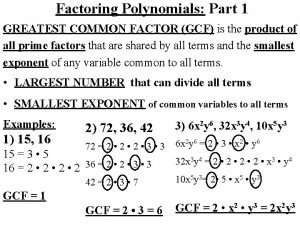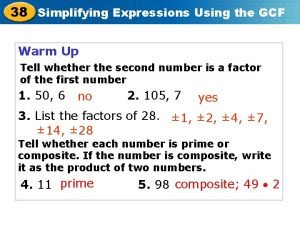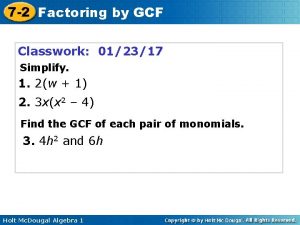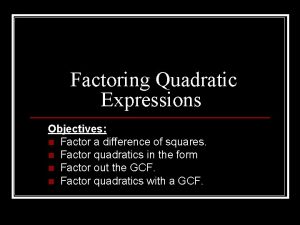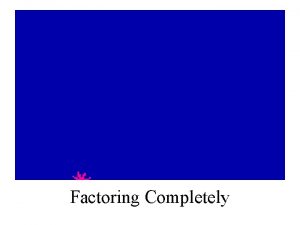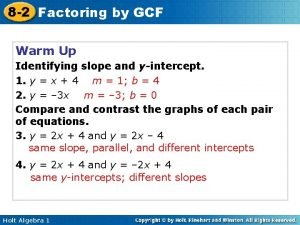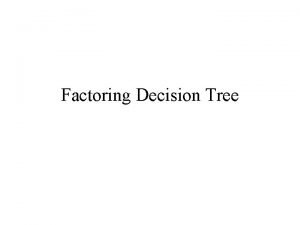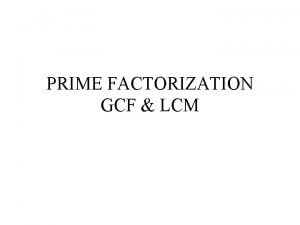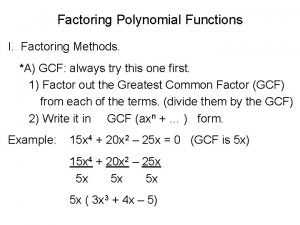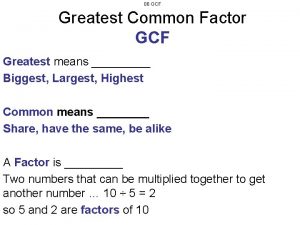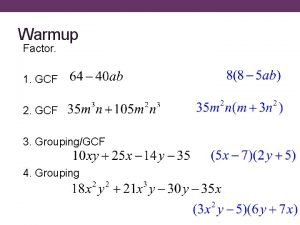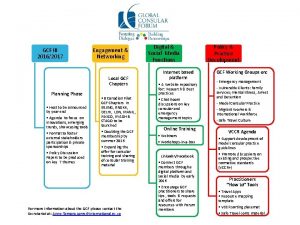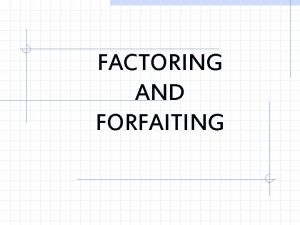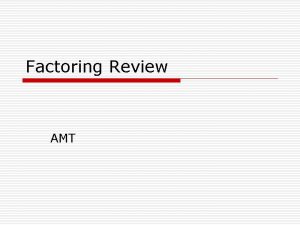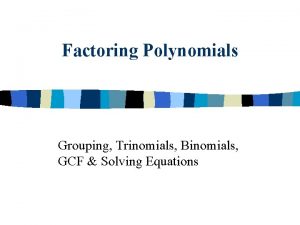Monday June 30 Factoring Factoring out the GCF





























- Slides: 29

Monday, June 30 Factoring

Factoring out the GCF

Greatest Common Factor The greatest common factor (GCF) is the product of what both items have in common. Example: 18 xy , 36 y 2 18 xy = 2 · 3 · x · y 2 36 y = 2 · 3 · y · y GCF = 2 · 3 · y = 18 y

Now you try! Find the greatest common factor of the following: Example 1: 2 2 2 12 a b , 90 a b c 2 GCF = 6 a b Example 2: 2 15 r , 35 s 2 , 70 rs GCF = 5

Factoring - Opposite of distributing - Breaking down a polynomial to what multiplies together to form the polynomial

Example: Factor: 2 12 a + 16 a 1. Factor each term. = 2· 2· 3·a·a + 2· 2·a 2. Pull out the GCF. = 2 · a (3·a + 2· 2) 3. Multiply. = 4 a (3 a + 4) You can check by distributing.

Example: Factor: 2 2 18 cd + 12 c d + 9 cd = 2· 3· 3·c·d·d + 2· 2· 3·c·c·d + 3· 3·c·d = 3 · c · d (2· 3·d + 2· 2·c + 3) = 3 cd (6 d + 4 c + 3)

Now you try! Example 1: 2 15 x + 25 x = 5 x(3 + 5 x) Example 2: 2 2 4 12 xy + 24 xy – 30 x y 3 = 6 xy(2 + 4 y – 5 xy )

Factoring by Grouping


1. Group Factor: terms with ( ). Example: 5 xy – 35 x + 3 y – 21 (5 xy – 35 x) + (3 y – 21) = 5 x (y – 7) + 3 (y – = (5 x + 3) (y – 7) 2. Pull out 7) GCF from each group. 3. Split into factors.

Notes - What is in parentheses MUST be the same!! - Grouping only works if there are 4 terms!!

Now you try! Factor. Example 1: 2 5 y – 15 y + 4 y - 12 = (5 y + 4)(y – 3) Example 2: 2 5 c – 10 c + 2 d – 4 cd = (5 c + 2 d)(1 – 2 c)

2 more important examples: Example 1: 2 xy + 7 x + 2 y + 7 (2 xy + 7 x) + (2 y + 7) = x (2 y + 7) + (2 y 1(2 y++7)7) = (x + 1) (2 y + 7)

Example 2: 15 a – 3 ab – 20 + 4 b (15 a – 3 ab) – (20 + – 4 b) = 3 a (5 – b) – 4 (5 – b) = (3 a – 4) (5 – b) If there is a negative in the middle, you MUST change the sign after it.

Factoring Trinomials

Example 1: 2 Factor: x + 5 x + 6 Look for factors of 6 that ADD to positive 5 (x + 2)(x + 3) 6 1· 6 2· 3

Example 2: 2 Factor: x + 7 x + 12 Look for factors of 12 that ADD to positive 7 (x + 3)(x + 4) 12 1 · 12 2· 6 3· 4

Now you try! 2 Example: x + 6 x + 8 (x + 2)(x + 4) 2 Example: x + 11 x + 10 (x + 1)(x + 10)

To determine the signs: Last sign Positive Middle sign Positive ( + ) Negative ( – ) Negative ( + )( – )

Example 3: 2 Factor: x – 12 x + 27 Look for factors of 27 that ADD to negative 12 (x – 3) (x – 9) 27 1 · 27 3· 9

Example 4: 2 Factor: x + 3 x – 18 Look for factors of 18 that SUBTRACT to positive 3 (x + 6)(x – 3) 18 1 · 18 2· 9 3· 6

Now you try! 2 Example: x – 20 (x + 4)(x – 5) 2 Example: x – 7 x – 18 (x + 2)(x – 9)

Please note! 2 Example: x – 5 x – 6 (x + 1)(x – 6) 2 Example: x – 5 x + 6 (x – 2)(x – 3)

More Factoring Trinomials

Example 1: 2 Factor: 6 x + 17 x + 5 30 1 · 30 22 6 x ++2 x) 2 x + 15 x (6 x (15 x++55) 2 · 15 2 x(3 x + 1) + 5(3 x + 1) 3 · 10 5 · 6 (2 x + 5)(3 x + 1)

Example 2: 2 Factor: 4 x + 24 x + 32 Always check your factors to see if there is anything more that can be factored out.

OR Example 2: 2 Factor: 4 x + 24 x + 32 It is usually faster if you factor out the GCF first. Always check to see if there is anything you can factor out first.

Now you try! 2 Example: 5 x + 27 x + 10 (5 x + 2)(x + 5) 2 Example: 24 x – 22 x + 3 (4 x – 3)(6 x – 1)
 The greatest common factor of 9x^2y 27xy^2 and 45x^2y^2
The greatest common factor of 9x^2y 27xy^2 and 45x^2y^2 Figurative language in one thing by one direction
Figurative language in one thing by one direction Factoring expressions using gcf
Factoring expressions using gcf Foil factoring
Foil factoring Factoring polynomials with gcf
Factoring polynomials with gcf Factoring expressions using gcf
Factoring expressions using gcf Factoring by gcf
Factoring by gcf 7-2 factoring by gcf answers
7-2 factoring by gcf answers Objectives of factoring
Objectives of factoring Factoring completely
Factoring completely Lesson 8-2 factoring by gcf
Lesson 8-2 factoring by gcf Solving quadratic equations by factoring gcf worksheet
Solving quadratic equations by factoring gcf worksheet Quiz 7-2 factoring by gcf
Quiz 7-2 factoring by gcf Quiz 7-2 factoring by gcf
Quiz 7-2 factoring by gcf Loto
Loto Out out by robert frost
Out out by robert frost Put out the light othello
Put out the light othello Bgsu quality systems
Bgsu quality systems Poem out out by robert frost
Poem out out by robert frost Out, damned spot! out, i say!
Out, damned spot! out, i say! Out of sight out of mind psychology
Out of sight out of mind psychology Time
Time Harmony not discord
Harmony not discord Allusion in out out
Allusion in out out Matthew 11 28-30 msg
Matthew 11 28-30 msg Makna out of sight out of mind
Makna out of sight out of mind Lock out tag out safety talk
Lock out tag out safety talk đặc điểm cơ thể của người tối cổ
đặc điểm cơ thể của người tối cổ Mật thư anh em như thể tay chân
Mật thư anh em như thể tay chân Bổ thể
Bổ thể
